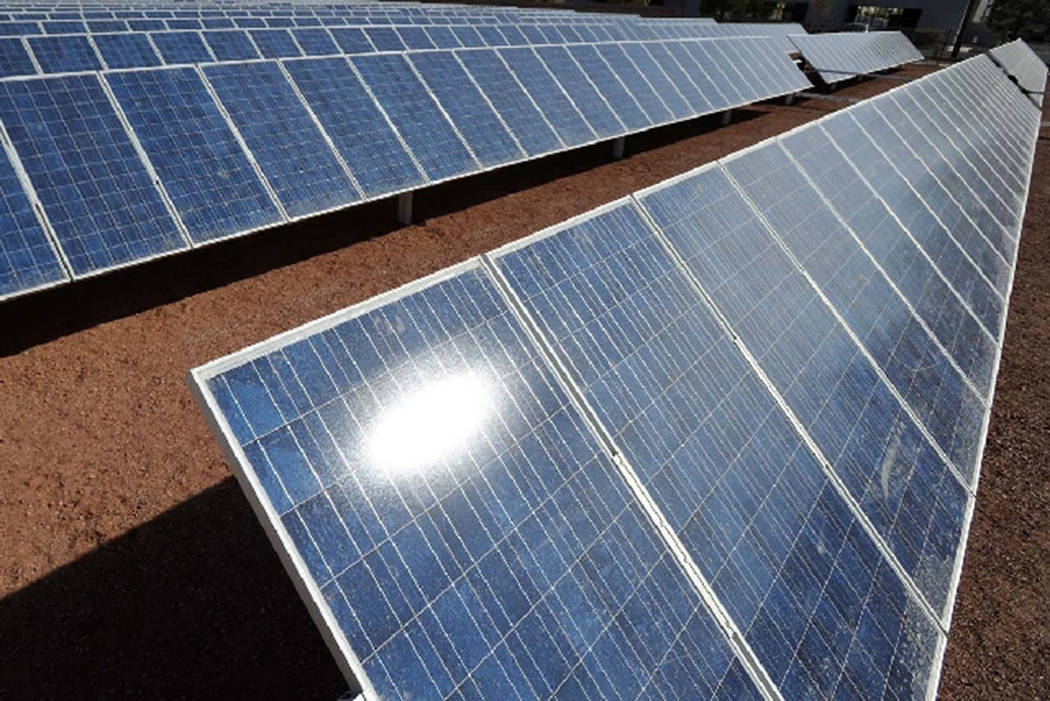BLM takes comments on massive solar project near Las Vegas
The Bureau of Land Management heard public comments Tuesday night on a proposed massive solar array near Valley of Fire State Park.
The event at Suncoast drew a few detractors, but the plan appears to be well on its way to implementation. The project, 30 miles northeast of Las Vegas, could power as many as 400,000 Las Vegas homes.
The BLM led two identical presentations discussing the three possible versions of the Gemini project, which will be built and maintained by Arevia Power LLC. Each presentation was bookended by separate “open house” time in which BLM employees could answer individual questions.
The government is weighing Arevia’s initial proposal, a more environmentally protective strategy that involves trimming native vegetation rather than flattening it — dubbed the all-mowing proposal — and a hybrid approach that combines trimming and flattening. Officials at Tuesday’s meeting said the BLM favors the hybrid model.
The main environmental concern is for the about the estimated 220 Mojave desert tortoises in the area. Each plan would involve moving the tortoises out of the project zone during construction, but the hybrid and all-mowing plans would allow at least some to return to their habitat and live near the arrays.
Arevia’s initial plan would not have allowed for tortoises to return to the 7,100-acre solar array.
BLM began collecting public comments in June and will continue to gather them until Sept. 5, after which it will choose a proposal and finalize plans. There will be another period for members of the public to protest the plans from November to December. The proposal then will go to Gov. Steve Sisolak, who has 60 days to lodge his own protests before BLM hands the reins over to Arevia.
Signs at Tuesday’s event stressed that the government was mainly looking for the public to identify inaccuracies or unclear sections of the proposals or offer new ones. BLM spokeswoman Kirsten Cannon said the agency was not looking for people to “vote” on which proposal they preferred, as the BLM has sole discretion over the choice.
The five people who delivered public comment Tuesday promptly ignored those instructions, with two saying they opposed the project in its entirety and three offering support.
Kevin Emmerich, director of nonprofit Basin and Range Watch, has opposed the plan since its inception and again voiced his opposition Tuesday.
“I’d like to see something a lot smaller,” Emmerich said, adding that rooftop solar in residential areas would more than cover the area’s electricity needs if people would make the upgrade.
Emmerich believes the tortoises and native plants will be in grave danger regardless of which proposal is selected.
Judy Bundorf said she was concerned for the desert bighorn sheep in the area. She added that it “sure would be a shame” if tourists had to drive through an industrial area to reach the Nevada’s oldest state park.
Max Carter and Forrest Darby offered support for the project as members of the International Brotherhood of Electrical Workers, which has signed on to contruct the array.
“This will create good, well-paying jobs for construction workers and provide affordable solar power for those of us who can’t afford upfront costs of rooftop solar,” Carter said.
Carter also noted the nearby Navajo Generating Station, a coal-fired power plant, is set to close down this year. The Arevia plant could replace a lot of the power output, with almost none of the environmental effects, while even using some of the same power lines and plants.
Rosalind Wilkes said very briefly that Nevada solar projects have kept her employed for the past four years and voiced her support.
Arevia representatives were also present to answer questions.
Once completed,
Gemini would be the largest project in the country to combine solar arrays and battery power, Arevia Managing Partner Ricardo Graf said in an interview. Arevia has smaller arrays under development in Colorado, New Mexico and Arizona.
The company signed a 25-year deal with NV Energy that will see all of the 690 megawatts generated by the panels and the 380 additional megawatts stored in the battery during the day to power about 400,000 Las Vegas homes. Graf said the battery allows for reliable power during peak energy consumption hours.
The array would also help Nevada reach its newly established goal of 50 percent renewable energy by 2030, Graf added.
Once a plan is approved, construction is anticipated to begin in the first half of 2020, Graf said. It will be a significant undertaking of several years and some 700 construction jobs. Arevia’s agreement with NV Energy requires the facility be online by December 2023.
Gemini will be operated and maintained by 15-20 permanent employees, Graf said.
“This is a stepping stone toward decarbonizing our electrical fleet,” Graf said. “We need more projects like Gemini, and I hope Gemini inspires future plans.”
Another BLM meeting is planned for 5:30 p.m. Wednesday at the Moapa Community Center, 1340 E. state Route 168.
^
Contact Rory Appleton at rappleton@reviewjournal.com or 702-383-0276. Follow @RoryDoesPhonics on Twitter.


















